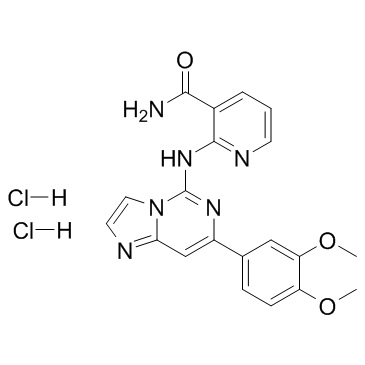| Description |
BAY 61-3606 (dihydrochloride) is a potent, ATP-competitive, reversible, and highly selective inhibitor of Syk tyrosine kinase (IC50=10 nM) with no inhibitory effect on Btk, Fyn, Itk, Lyn, and Src.
|
| Related Catalog |
|
| Target |
IC50: 10 nM (Syk)
|
| In Vitro |
BAY 61-3606 inhibits the release of various inflammatory mediators in a concentration-dependent manner. The IC50 values for the FcϵRI-mediated hexosaminidase release from a rat basophilic leukemia cell line, RBL-2H3, and serotonin release from rat peritoneal mast cells are found to be 46 and 17 nM, respectively. BAY 61-3606 inhibits FcϵRI-mediated histamine and tryptase release from HCMCs with IC50 values of 5.1 and 5.5 nM, respectively, in a manner similar to its effect on the degranulation of RBL-2H3 cells and rat peritoneal mast cells. BAY 61-3606 inhibits histamine release from leukocytes in high and low IgE groups equipotently, giving IC50 values of 8.1 and 10 nM, respectively[1]. BAY 61-3606 affects viability in cells expressing mutant K-RAS or B-RAF through a MAPK-independent pathway. Inhibition of SYK is not responsible for the BAY 61-3606 effect on cell viability in colorectal cancer cells. MAP4K2 is a target for BAY 61-3606 that modulates the response of wild-type cells to AZ-628[2]. BAY61-3606 has a 50% Cytotoxicity Concentration (CC50) value of greater than 100 μM, and it inhibits AD169 replication[3].
|
| In Vivo |
BAY 61-3606 (3, 10, 30, 100 mg/kg, p.o.) dose dependently inhibits the PCA reaction with an ED50 value of 8 mg/kg. In a bronchoconstriction model, BAY 61-3606 dose dependently inhibits the DNP-BSA-induced increase in pulmonary pressure, and the dose of 3 mg/kg shows statistically significant suppression[1].
|
| Kinase Assay |
GST-Syk (3.2 ng), 0.5 μg AL, 30 μM ATP, and testing compound in the presence of 0.25% Me2SO are mixed in 50 μL/well of kinase assay buffer in polypropylene U-bottom 96-well microtiter plates. The mixture is incubated for 1 h at room temperature, and the reaction is terminated by the addition of 120 μL of termination buffer. To capture AL, 120 μL of the terminated mixture is transferred to streptavidin-coated plates, followed by incubation at room temperature for more than 30 min. After three ishes with washing buffer, 100 μL of antibody buffer is added and incubated at room temperature for more than 30 min. After three more ishes, 100 μL of enhancement solution is added. Time-resolved fluorescence is measured by multilabel counter ARVO.
|
| Cell Assay |
HFF cells are seeded at a density of 1×104 cells per well into 96-well plates. After 4 hours incubation to allow cell attachment, cells are treated for the time indicated in the text with different concentrations of each compound in duplicate. Cell viability is then determined with an MTT assay according to the manufacturer's protocol. The final concentration of DMSO in all samples is maintained at <1% (v/v). As a positive control, in all experiments a 2-fold dilution series of HFF cells starting at 1×104 cells per well is included.
|
| Animal Admin |
Rats: Rats are immunized by i.p. injection of OVA in Al(OH)3 suspension on days 0 and 14. On days 20 and 21, an aerosol of 1% OVA in saline is administered by inhalation. BAL fluid is collected, and cell number and differential counts are determined. BAY 61-3606 is administered (p.o.) from days 0 to 21 (b.i.d.). Dexamethasone is administered (p.o.) from days 0 to 9 and days 18 to 21 (b.i.d.).
|
| References |
[1]. Yamamoto N, et al. The orally available spleen tyrosine kinase inhibitor 2-[7-(3,4-dimethoxyphenyl)-imidazo[1,2-c]pyrimidin-5-ylamino]nicotinamide dihydrochloride (BAY 61-3606) blocks antigen-induced airway inflammation in rodents. J Pharmacol Exp Ther. 2 [2]. Lau KS, et al. BAY61-3606 affects the viability of colon cancer cells in a genotype-directed manner. PLoS One. 2012;7(7):e41343. [3]. Ho CM, et al. Inhibition of IKKα by BAY61-3606 Reveals IKKα-Dependent Histone H3 Phosphorylation in Human Cytomegalovirus Infected Cells. PLoS One. 2016 Mar 1;11(3):e0150339.
|
